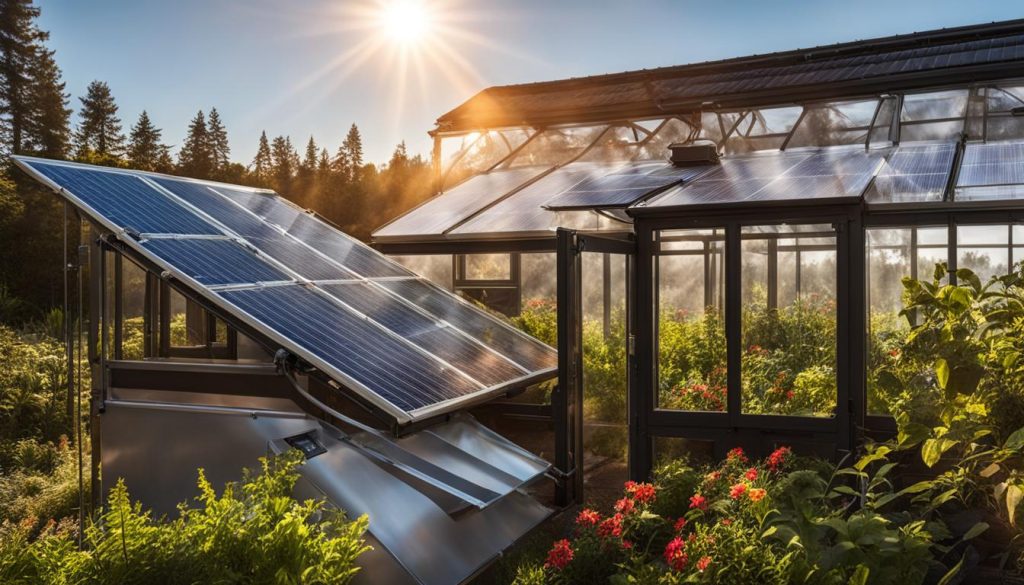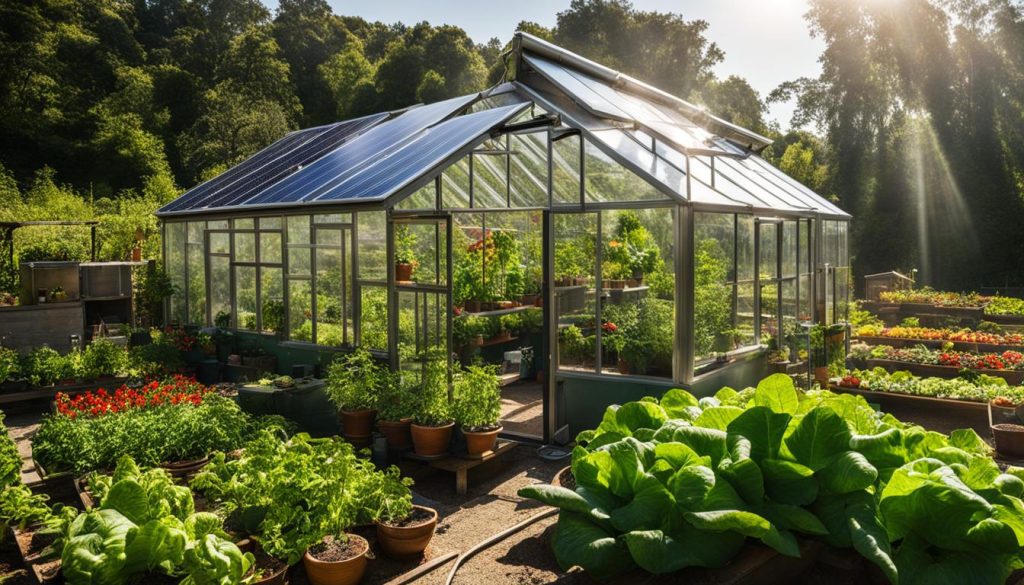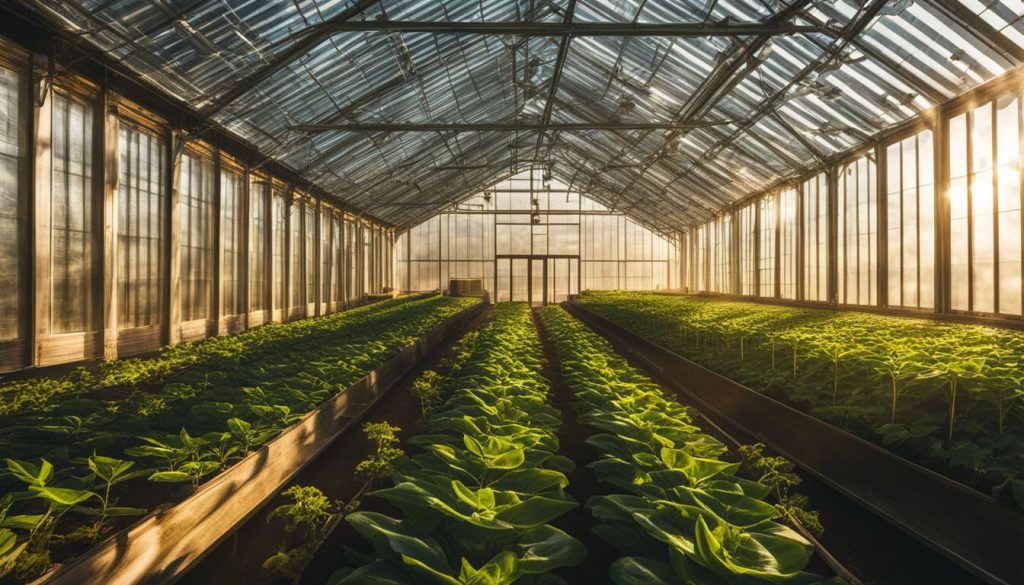Welcome to our comprehensive guide on how to effectively heat a greenhouse with solar panels. Harnessing the power of solar energy is not only sustainable but can also save greenhouse operators significant costs in the long run. In this article, we will explore various aspects of solar panel greenhouse heating and provide valuable insights to help you make informed decisions for your greenhouse heating needs.
Heating a greenhouse with solar energy offers numerous benefits, including reduced reliance on traditional heating methods and a smaller carbon footprint. However, it’s essential to understand the limitations and considerations associated with solar-powered greenhouse heating to ensure optimal results. By combining solar panels with other heating methods, you can effectively maintain the ideal temperature for your plants throughout the year.
Key Takeaways:
- Solar panels provide an eco-friendly solution for greenhouse heating.
- Combining solar panels with other heating methods can optimize greenhouse temperature control.
- Factors such as greenhouse size, panel placement, and sunlight exposure need to be considered when choosing a solar heating system.
- Solar greenhouse heaters can be standalone or integrated into existing heating systems.
- Proper setup and maintenance are crucial for maximizing solar panel efficiency.
What Is a Solar Greenhouse Heater?
A solar greenhouse heater is an innovative system that utilizes the power of the sun to provide heat for a greenhouse. It converts the sun’s energy into thermal energy, which is then distributed throughout the greenhouse to maintain an optimal temperature for plant growth. There are two main types of collectors used in solar greenhouse heaters: photovoltaic (PV) panels and solar heat absorption panels.
Photovoltaic (PV) Panels: PV panels are the most common type of solar collector used in greenhouse heating systems. They generate electricity from sunlight and convert it into heat through an electric heater. This heat is then distributed throughout the greenhouse to raise the ambient temperature. PV panels offer the advantage of being able to generate electricity for other purposes, such as powering fans or pumps.
Solar Heat Absorption Panels: Solar heat absorption panels, also known as solar thermal collectors, directly produce heat from sunlight. These panels absorb solar radiation and convert it into thermal energy, which is then distributed through convection or a circulation fan powered by a separate PV panel. Solar heat absorption panels are often used in conjunction with other heating methods to provide consistent and efficient greenhouse heating.
“A solar greenhouse heater converts the sun’s energy into thermal energy, which is then distributed to heat the greenhouse.”
Another simpler option is a solar furnace, which consists of a black panel that absorbs sunlight, heats the air, and circulates it back into the greenhouse. Solar furnaces are a cost-effective solution for smaller greenhouses and can be easily installed on the walls or roof of the structure.
Overall, solar greenhouse heaters provide a sustainable and renewable way to heat a greenhouse, reducing reliance on traditional energy sources and minimizing carbon emissions. By harnessing the power of the sun, these systems offer an environmentally friendly solution for maintaining optimal growing conditions in a greenhouse.
What To Consider When Buying a Solar Greenhouse Heater
When purchasing a solar greenhouse heater, there are several important factors to consider. These factors will ensure that you choose the right heater for your greenhouse, taking into account its size, purpose, and available space for panels.
Greenhouse Size
The size of your greenhouse is a crucial factor in determining the heating requirements. Larger greenhouses will require more heat, and therefore, more solar panels. It’s important to accurately calculate the size of your greenhouse and choose a solar heater that can provide enough heat to maintain optimal growing conditions.
Greenhouse Purpose
The purpose of your greenhouse will also influence the type of solar heater you choose. Different crops or plants may have specific temperature requirements, so it’s important to consider these needs when selecting a solar heater. For example, certain plants may require higher temperatures, which may require a more powerful solar heater or additional heating methods.
Available Space for Panels
The available space for solar panels is another crucial consideration. Solar panels need to be positioned in a clear, south-facing area to maximize sunlight exposure. It’s important to assess the available space in your greenhouse and determine whether it can accommodate the required number of panels for effective heating.
By carefully considering these factors, you can make an informed decision when buying a solar greenhouse heater. This will ensure that you choose a heater that is suitable for your greenhouse size, purpose, and available space, providing efficient and effective heating for your plants.

Types of Solar Greenhouse Heaters
Solar greenhouse heaters offer a variety of options to suit different heating needs. Here are three common types of solar greenhouse heaters:
PV Panels
PV panels, also known as photovoltaic panels, are a popular choice for solar greenhouse heating. These panels generate electricity from sunlight and can power electric space heaters inside the greenhouse. PV panels are efficient and can provide consistent heating, especially when paired with a battery storage system to store excess energy for use during nighttime or cloudy days.
Solar Furnaces
A solar furnace is another type of solar greenhouse heater that heats the air directly. It consists of a black panel that absorbs sunlight and transfers the heat to the air before circulating it back into the greenhouse. Solar furnaces can be installed in the greenhouse walls to maximize space and provide effective heating. They are a simple and cost-effective option for greenhouse owners.
Hot Water Panels
Hot water panels are specifically designed to heat water, which is then circulated through pipes in the greenhouse floor or walls. These panels absorb sunlight and transfer the heat to the water, which helps maintain a regulated temperature inside the greenhouse. Hot water panels are a versatile option and can be integrated with existing heating systems or used as a standalone solution.
| Type | Description |
|---|---|
| PV Panels | Generate electricity to power electric space heaters |
| Solar Furnaces | Heat the air directly using a black panel |
| Hot Water Panels | Heat water for circulation through pipes in the greenhouse |
When choosing a solar greenhouse heater, consider the specific heating requirements of your greenhouse and select the type that best meets your needs. Each type has its own advantages and can contribute to effective and efficient greenhouse heating.
Pros and Cons of Solar Greenhouse Heaters
Solar greenhouse heaters offer a range of benefits, but they also come with some limitations. Understanding the pros and cons of using solar greenhouse heaters is essential for making an informed decision.
One of the most significant advantages of solar greenhouse heaters is that they provide free energy. By harnessing the power of the sun, greenhouse owners can significantly reduce their reliance on traditional heating methods, resulting in significant cost savings in the long run.
Additionally, solar greenhouse heaters are an eco-friendly solution. They utilize renewable energy, reducing greenhouse gas emissions and minimizing the carbon footprint of greenhouse operations.
“Solar greenhouse heaters offer free energy and reduce reliance on traditional heating methods, but they come with challenges such as sunlight dependency and installation requirements.”
However, it’s important to consider the challenges associated with solar greenhouse heaters. These systems are dependent on sunlight availability, which means they may not be able to provide consistent heating during cloudy days or at night. Therefore, backup heating systems or energy storage solutions are necessary to ensure a continuous heat supply.
Furthermore, the installation and maintenance of solar panels for greenhouse heating can be challenging. Proper panel placement is essential to maximize sunlight exposure, and regular cleaning is necessary to prevent any decrease in efficiency. These factors require careful planning and ongoing attention to ensure optimal performance.
Pros and Cons of Solar Greenhouse Heaters:
| Pros | Cons |
|---|---|
| Free energy | Dependent on sunlight availability |
| Reduced reliance on traditional heating methods | Installation and maintenance challenges |
| Eco-friendly |
Despite these challenges, the use of solar greenhouse heaters can be a cost-effective and sustainable solution for greenhouse owners who prioritize energy efficiency and environmental responsibility.

Table: Pros and Cons of Solar Greenhouse Heaters
Three Top Solar Greenhouse Heaters
Solar greenhouse heaters are an excellent option for heating your greenhouse sustainably. Here are three top solar greenhouse heaters that you should consider:
Nakoair Solar Air Collector
The Nakoair Solar Air Collector is a highly efficient solar furnace-style heater. It uses the power of the sun to heat the air, which is then pumped into the greenhouse. This heater can warm the air in your greenhouse 40 to 85 degrees Fahrenheit warmer than the outdoor air temperature. It is a reliable and cost-effective option for heating larger greenhouse spaces.
Bio Green PAL Greenhouse Heater
The Bio Green PAL Greenhouse Heater is a powerful electric heater designed specifically for greenhouse use. This heater can warm up to 120 square feet of greenhouse space, making it perfect for smaller to medium-sized greenhouses. It is easy to install and operate, providing consistent and reliable warmth for your plants.
Renology 200W Solar Starter Kit
If you are looking for a solar panel solution to power your greenhouse heating system, the Renology 200W Solar Starter Kit is a great choice. This starter kit features a high-efficiency monocrystalline panel that can charge a battery pack. The battery pack can then power an electric heater, providing a sustainable heating solution for your greenhouse.
These three solar greenhouse heaters offer different options depending on the size and heating needs of your greenhouse. Consider your specific requirements and choose the heater that best suits your needs for efficient greenhouse heating powered by solar energy.
How to Set Up Solar Panels for a Greenhouse
Properly setting up solar panels for a greenhouse is essential to ensure optimal energy production and heating efficiency. Here are some key considerations to keep in mind:
1. Solar Panel Placement
The placement of solar panels plays a critical role in maximizing sunlight exposure. Ideally, the panels should face south at a 30-45 degree angle to capture the most sunlight throughout the day. Avoid shading from trees, buildings, or other obstructions that could limit sunlight access to the panels.
2. Greenhouse Size and Sunlight Exposure
The size of the greenhouse and the amount of sunlight it receives are important factors in determining how many solar panels are needed. Larger greenhouses require more panels to generate sufficient energy for heating. Additionally, consider the amount of sunlight the greenhouse receives throughout the year, as this can vary depending on the location.
3. Battery Storage
For consistent energy supply, battery storage may be necessary to store excess energy generated by the solar panels. Batteries allow greenhouse operators to use stored energy during nighttime or cloudy days when sunlight is limited. Choose a battery system that is suitable for your greenhouse’s energy needs and consider factors such as capacity and lifespan.
| Factors to Consider | Solar Panel Placement | Greenhouse Size | Sunlight Exposure | Battery Storage |
|---|---|---|---|---|
| Importance | High | Medium | Medium | High |
| Considerations | South-facing angle, avoid shading | Determine heating requirements | Assess sunlight availability | Select appropriate battery system |
| Impact on Heating Efficiency | Maximizes solar energy capture | Ensures sufficient energy supply | Optimizes energy production | Provides backup power |
By carefully considering solar panel placement, greenhouse size, sunlight exposure, and battery storage, greenhouse operators can effectively set up solar panels to maximize energy production and efficiently heat their greenhouse.
Conclusion
In conclusion, solar panels provide an efficient and sustainable solution for heating greenhouses. By harnessing renewable energy from the sun, greenhouse owners can reduce their reliance on traditional heating methods and contribute to a greener future.
With the right setup, solar-powered greenhouses can benefit from consistent and cost-effective heating throughout the year. By utilizing solar panels for greenhouse heating, greenhouse operators can not only save on energy costs but also reduce their carbon footprint.
However, it is important to consider factors such as panel placement, greenhouse size, and sunlight exposure when installing and maintaining solar panels. Proper positioning of the panels and assessing the energy needs of the greenhouse are crucial for optimal performance.
Overall, solar panels offer a sustainable and eco-friendly way to heat greenhouses, making them an increasingly popular choice for greenhouse owners who prioritize renewable energy sources.
FAQ
Can solar greenhouse heaters be used as a sole heating system for a greenhouse?
Solar greenhouse heaters can be used as a supplement to existing heating systems. While standalone solar greenhouse heaters are available, larger spaces may require a full solar array connected to a heat pump or resistive heater.
What types of collectors are used in solar greenhouse heaters?
There are two types of collectors used in solar greenhouse heaters: photovoltaic (PV) panels and solar heat absorption panels.
How do PV panels work in solar greenhouse heaters?
PV panels generate electricity that is converted into heat through an electric heater.
How do solar heat absorption panels work in solar greenhouse heaters?
Solar heat absorption panels produce heat directly and distribute it through convection or a circulation fan powered by a separate PV panel.
What should I consider when buying a solar greenhouse heater?
When purchasing a solar greenhouse heater, consider the size and purpose of the greenhouse, as well as the available space for panels.
What are the different types of solar greenhouse heaters available?
There are several types of solar greenhouse heaters available, including PV panels for electric space heaters, solar furnaces, and hot water panels.
What are the pros and cons of using solar greenhouse heaters?
Solar greenhouse heaters offer benefits such as free energy and reduced reliance on traditional heating methods, but their availability is dependent on sunlight and they require storage systems or backup heating for nighttime and cloudy days.
Can you recommend any top solar greenhouse heaters?
Three top solar greenhouse heaters are the Nakoair Solar Air Collector, the Bio Green PAL Greenhouse Heater, and the Renology 200W Solar Starter Kit.
How should I set up solar panels for a greenhouse?
Proper placement of solar panels is crucial for maximizing sunlight exposure. South-facing panels at a 30-45 degree angle are ideal. Consider the size of the greenhouse and the amount of sunlight it receives when determining the number of panels needed. Battery storage may also be necessary.
How effective are solar panels for greenhouse heating?
Solar panels offer an effective and eco-friendly way to heat a greenhouse, reducing reliance on traditional methods and lowering carbon footprint.

